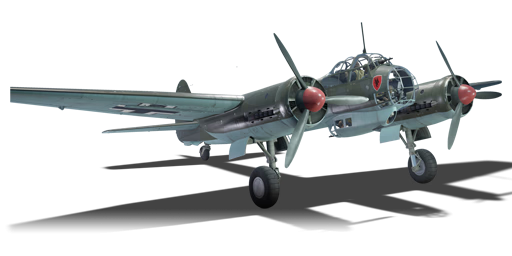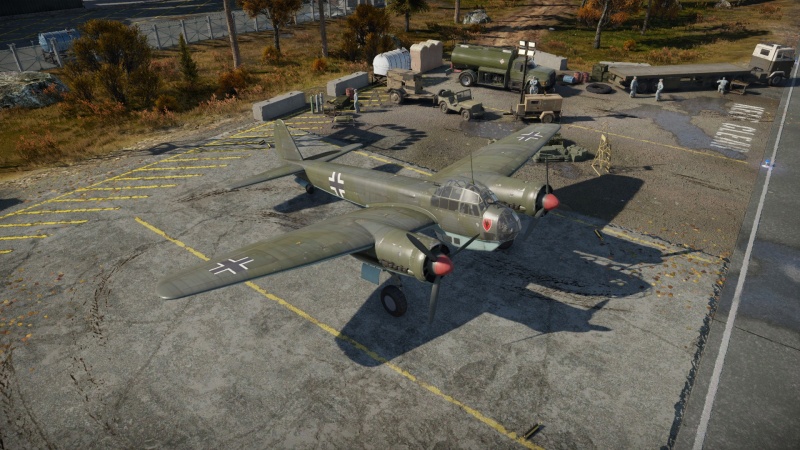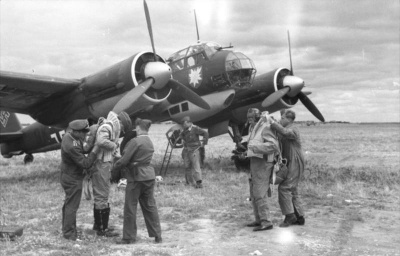Difference between revisions of "Ju 88 A-1"
m (→Details: Corrected optimal velocities values) |
prohack028 (talk | contribs) (→Usage in battles) (Tag: Visual edit) |
||
| Line 132: | Line 132: | ||
== Usage in battles == | == Usage in battles == | ||
| − | + | The Ju-88 A is a typical bomber with enough speed and a barely adequate bomb load. | |
| + | |||
| + | In any air AB/RB match, attack enemy AI units as the bombs barely have enough potency to destroy 1 base (24x SC50JA bombs, 7x SC250JA bombs, 3x SC500K bombs required to destroy 1 base in Air RB). For experienced gunners, it will be slightly challenging to hit planes directly perpendicular to you as there are 3 gunners that al face either behind or forwards, creating a massive blank spot in the middle of the plane. | ||
| + | |||
| + | In ground RB matches, it is recommended to carry the 2x SC500K bombs given from research as they can help you destroy some ground targets. Reach max altitude of 9800 meters and place a bomb fuse of 0 seconds, then release on any main objectives as you only have 2 bombs. If you are under attack, force the enemy to tailgate you as that is your only chance in returning back to base. Dive down and watch your gunners open fire at the enemy and try to figure out where they are. If your tail controls are out, you are but a sitting duck to be killed instantly. If flaps still exist, try to use them as a "elevator" replacement. | ||
| + | |||
| + | Major tip: Just stay alive (and don't use this) | ||
| + | |||
| + | Bomb target loadout: [https://docs.google.com/spreadsheets/d/1tEW1fsdRYsmVZbQjH4rBAaPfUnmNpnN-Ypc-vwgthP0/pubhtml link here] | ||
=== Manual Engine Control === | === Manual Engine Control === | ||
| Line 192: | Line 200: | ||
== See also == | == See also == | ||
''Links to the articles on the War Thunder Wiki that you think will be useful for the reader, for example:'' | ''Links to the articles on the War Thunder Wiki that you think will be useful for the reader, for example:'' | ||
| + | |||
* ''reference to the series of the aircraft;'' | * ''reference to the series of the aircraft;'' | ||
* ''links to approximate analogues of other nations and research trees.'' | * ''links to approximate analogues of other nations and research trees.'' | ||
| Line 207: | Line 216: | ||
=== Works Cited === | === Works Cited === | ||
| + | |||
* V, R. (2019). Junkers Ju 88. Retrieved November 25, 2020, from <nowiki>http://www.century-of-flight.freeola.com/Aviation%20history/WW2/Junkers%20Ju%2088.htm</nowiki> | * V, R. (2019). Junkers Ju 88. Retrieved November 25, 2020, from <nowiki>http://www.century-of-flight.freeola.com/Aviation%20history/WW2/Junkers%20Ju%2088.htm</nowiki> | ||
* Rickard, J. (2007, June 30). Ju 88A. Retrieved November 25, 2020, from <nowiki>http://www.historyofwar.org/articles/weapons_ju88A.html</nowiki> | * Rickard, J. (2007, June 30). Ju 88A. Retrieved November 25, 2020, from <nowiki>http://www.historyofwar.org/articles/weapons_ju88A.html</nowiki> | ||
Revision as of 06:52, 14 March 2022
| This page is about the German bomber Ju 88 A-1. For other variants, see Ju 88 (Family). |
Contents
Description
The Ju 88 A-1 is a rank II German bomber with a battle rating of 2.7 (AB/SB) and 2.0 (RB). It was introduced in Update 1.55 "Royal Armour".
General info
Flight performance
| Characteristics | Max Speed (km/h at 5,600 m) |
Max altitude (metres) |
Turn time (seconds) |
Rate of climb (metres/second) |
Take-off run (metres) | |||
|---|---|---|---|---|---|---|---|---|
| AB | RB | AB | RB | AB | RB | |||
| Stock | 430 | 416 | 9800 | 31.5 | 32.9 | 3.8 | 3.8 | 530 |
| Upgraded | 482 | 455 | 28.5 | 30.0 | 10.9 | 6.8 | ||
Details
| Features | ||||
|---|---|---|---|---|
| Combat flaps | Take-off flaps | Landing flaps | Air brakes | Arrestor gear |
| ✓ | ✓ | ✓ | ✓ | X |
| Limits | ||||||
|---|---|---|---|---|---|---|
| Wings (km/h) | Gear (km/h) | Flaps (km/h) | Max Static G | |||
| Combat | Take-off | Landing | + | - | ||
| 0 | 310 | 457 | 428 | 280 | ~10 | ~10 |
| Optimal velocities (km/h) | |||
|---|---|---|---|
| Ailerons | Rudder | Elevators | Radiator |
| < 350 | < 360 | < 370 | > 331 |
| Compressor (RB/SB) | ||
|---|---|---|
| Setting 1 | ||
| Optimal altitude | 100% Engine power | WEP Engine power |
| 5,000 m | 1,834 hp | 2,366 hp |
Survivability and armour
- No armour plating
- No armour glazing
- Engines and all fuel tanks in wings
Modifications and economy
Armaments
Offensive armament
The Ju 88 A-1 is armed with:
- 1 x 7.92 mm MG 15 machine gun, nose-mounted (375 rpg)
Suspended armament
The Ju 88 A-1 can be outfitted with the following ordnance:
- 10 x 50 kg SC50JA bombs (500 kg total)
- 28 x 50 kg SC50JA bombs (1,400 kg total)
- 2 x 250 kg SC250JA bombs + 28 x 50 kg SC50JA bombs (1,900 kg total)
- 4 x 250 kg SC250JA bombs (1,000 kg total)
- 2 x 500 kg SC500K bombs (1,000 kg total)
Defensive armament
The Ju 88 A-1 is defended by:
- 1 x 7.92 mm MG 15 machine gun, dorsal turret (600 rpg)
- 1 x 7.92 mm MG 15 machine gun, ventral turret (525 rpg)
Usage in battles
The Ju-88 A is a typical bomber with enough speed and a barely adequate bomb load.
In any air AB/RB match, attack enemy AI units as the bombs barely have enough potency to destroy 1 base (24x SC50JA bombs, 7x SC250JA bombs, 3x SC500K bombs required to destroy 1 base in Air RB). For experienced gunners, it will be slightly challenging to hit planes directly perpendicular to you as there are 3 gunners that al face either behind or forwards, creating a massive blank spot in the middle of the plane.
In ground RB matches, it is recommended to carry the 2x SC500K bombs given from research as they can help you destroy some ground targets. Reach max altitude of 9800 meters and place a bomb fuse of 0 seconds, then release on any main objectives as you only have 2 bombs. If you are under attack, force the enemy to tailgate you as that is your only chance in returning back to base. Dive down and watch your gunners open fire at the enemy and try to figure out where they are. If your tail controls are out, you are but a sitting duck to be killed instantly. If flaps still exist, try to use them as a "elevator" replacement.
Major tip: Just stay alive (and don't use this)
Bomb target loadout: link here
Manual Engine Control
| MEC elements | ||||||
|---|---|---|---|---|---|---|
| Mixer | Pitch | Radiator | Supercharger | Turbocharger | ||
| Oil | Water | Type | ||||
| Not controllable | Controllable Auto control available |
Controllable Auto control available |
Controllable Auto control available |
Separate | Not controllable 1 gear |
Not controllable |
Pros and cons
Pros:
- Has an offensive forward-firing machine gun.
- Ability to dive bomb, equipped with air brakes.
- Carries a decent max load of 1,900 kg compared to contemporaries, third highest payload before the Ju-88 A-4 and the He 111 H-3.
- Lots of armament options.
- Airframe can withstand high speed during a dive.
- Carrying the maximum payload doesn't have that much penalty in overall performance.
- Very useful in precision bombing.
- Can outrun lower-end fighters.
- The 50 kg bombs are very efficient in taking out individual ground targets.
Cons:
- Defensive armaments are poor.
- Stock bomb load is inadequate.
- Payload is inferior to that of the Ju 88 A-4.
History
The Junkers Ju 88 A-1 was the first variant of the Junkers Ju 88, a German fast bomber. Designed as a super-versatile aircraft, the Ju 88 fulfilled a variety of roles including frontline bomber, torpedo-bomber, minelayer and reconnaissance platform. The aircraft saw extensive service during the Battle of Britain, and later over Soviet skies during Operation Barbarossa. The design of the aircraft was highly obsolete by the end of the war; despite this, over 15,000 Ju 88s of all variants were built.[1][2]
Design and development
The Ju 88 originated from a 1935 requirement for a new high-speed dive bomber with a crew of 3, capable of reaching 480 km/h.[1] The Henschel and Messerschmitt design firms also submitted designs, but later withdrew them; thus, Junkers won the competition and proceeded to produce prototypes. The first Ju 88 prototype flew in December of 1936, and managed to reach a speed of 520 km/h;[1] Later on, a pre-production Ju 88 set a record for a 1,000 kilometre circuit, averaging 517 km/h. After the completion of ten prototypes of the Ju 88 A-0 series, the Ju 88 A-1 was ordered into production with deliveries starting in 1939.[1]
The Ju 88 is a conventional twin-engined light bomber, with the engines mounted in nacelles on each wing. The aircraft has a crew of three, being a pilot, bombardier and radio operator/rear gunner. The aircraft's armament was sparse, consisting of just three 7.92 mm machine guns; this was steadily improved in later Ju 88 variants. The A-1 could carry a maximum bomb load of 1,000 kilograms in standard load, though heavier loads could be carried with modifications.[1]
Operational history
The Ju 88 A-1 started entering service with the Luftwaffe in 1939; 69 aircraft were built that year.[2] The aircraft saw its first combat attacking British shipping in the fall of 1939.[2] The aircraft served extensively in the Battle of Britain as the main Luftwaffe bomber, and fulfilled the same role in Operation Barbarossa, the attempted German invasion of the USSR. By that point in time, it was complemented by more advanced variants of the Ju 88 such as the Ju 88 A-4.
During its time in service, it became highly apparent that the Ju 88 A-1 was not well suited to its task. Namely, the aircraft wasn't adequately armed, with just three defensive machine guns.[2] Thus, the later Ju 88 A-4 variant introduced a heavier defensive armament of five 7.92 mm machine guns; later derivatives such as the Ju 188 featured even more defensive armament.[2] As well, the aircraft experienced structural strength issues, which prevented it from entering fast dives without breaking up. This was also remedied by the later Ju 88 A-4.[2] Despite its flaws, the Ju 88 was a versatile, reliable aircraft and over 15,000 aircraft were built before the end of the war.[1][2]
Media
Excellent additions to the article would be video guides, screenshots from the game, and photos.
See also
Links to the articles on the War Thunder Wiki that you think will be useful for the reader, for example:
- reference to the series of the aircraft;
- links to approximate analogues of other nations and research trees.
External links
References
Works Cited
- V, R. (2019). Junkers Ju 88. Retrieved November 25, 2020, from http://www.century-of-flight.freeola.com/Aviation%20history/WW2/Junkers%20Ju%2088.htm
- Rickard, J. (2007, June 30). Ju 88A. Retrieved November 25, 2020, from http://www.historyofwar.org/articles/weapons_ju88A.html
| Junkers Aircraft and Motor Works (Junkers Flugzeug- und Motorenwerke Aktiengesellschaft) | |
|---|---|
| Fighters | Ju 88 C-6 · Ju 388 J |
| Strike Aircraft | |
| Ju 87 | Ju 87 G-1 · Ju 87 G-2 |
| Bombers | Ju 88 A-1 · Ju 88 A-4 · Ju 188 A-2 · Ju 288 C |
| Ju 87 | Ju 87 B-2 · Ju 87 D-3 · Ju 87 D-5 · Ju 87 R-2 · Ju 87 R-2 Libya |
| Export | ▄Ju 87 D-3 · ▄Ju 87 R-2 · ▄Ju 88 A-4 |
| Germany bombers | |
|---|---|
| Arado | Ar 196 A-3 |
| Blohm & Voss | BV 138 C-1 · BV 238 |
| Dornier | Do 17 E-1 · Do 17 Z-2 · Do 217 E-2 · Do 217 E-4 · Do 217 K-1 · Do 217 M-1 |
| Focke-Wulf | Fw 189 A-1 · Fw 200 C-1 |
| Henschel | Hs 123 A-1 |
| Heinkel | He 111 H-3 · He 111 H-6 · He 111 H-16 · He 115 C-1 · He 177 A-3 · He 177 A-5 |
| Junkers | Ju 87 B-2 · Ju 87 R-2 · Ju 87 R-2 Libya · Ju 87 D-3 · Ju 87 D-5 · Ju 88 A-1 · Ju 88 A-4 · Ju 188 A-2 · Ju 288 C |
| Messerschmitt | Me 264 |
| Savoia-Marchetti | ▀S.M.79 serie 1 · ▀S.M.79 B · ▀S.M.79 serie 4 · ▀S.M.79 serie 8 |
| ▀S.M.79 AS · ▀S.M.79 bis/N · ▀S.M.79 bis/T.M | |
| Trophies | ▀Wellington Mk Ic |






